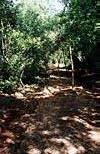  

By Joel Skidmore The Chichen Itza Archaeological Project, under the direction of Peter Schmidt, has carried out an extensive course of work since 1993. Its principal goals have been to map the entire site, compile a stratigraphic chronology, study the ceramics and restore the numerous structures that had been left only partially excavated in the past. This brief summary of the work is based on articles by Peter Schmidt in Arqueología Mexicana (Schmidt 1994, 1999), a newspaper report in Diario de Yucatán republished on the Web (http://chichen.sureste.com: article 944), and personal communications with Schmidt (2000, 2001). |
|
Excavation and building restoration work began with the structure adjacent to the Temple of the Warriors on the north, the Temple of the Tables (designated Structure 2D7 because it is building number 7 in sector 2D on the Carnegie map). In excavating through the stairway, an earlier structure was discovered, which had been partially dismantled in order to construct the final building phase. For reasons of stability, it was impossible to fully liberate the earlier building, which had remnants of stucco and polychrome paint. The vaults were adorned with large, undulating serpents, similar to the substructure of the Temple of the Warriors. The original facade had been dismantled. For the same reasons of stability, only two sides of the interior piers were liberated. These were decorated with life-size figures of warriors, carved in stone relief with details in stucco and polychrome paint.
In the nearby northeast corner of the Patio of the Thousand Columns, three structures (3E1, 3D5/D6 and 3D7) were explored, excavated and consolidated. On the north side of the Northeast Colonnade (3E1), which was still covered with the original rubble, excavation revealed one of the most interesting ceramic lots encountered thus far. Comprising over 90,000 sherds of Sotuta horizon, this had been overlooked in the early investigations of the Carnegie Institution of Washington. Structure 3E5/E6, immediately to the west, had been partly remodeled and filled in during Precolumbian times in order to create a second story. This presented a unique iconographic and epigraphic aspect. Between human figures and rows of shields (the originals probably of turquoise) were rampant felines in Maya-Toltec style. Amongst the spots which identified these latter as jaguars were the Maya glyphs for ajaw and k'awiil, including phonetic complements. According to Schmidt, this leaves no doubt that the lineage or lord to whom the palace belonged was named was named B'alam ("Jaguar") Ajaw K'awiil or B'alam K'awiil Ajaw. The upper facade of this structure was decorated with masks, lords seated on the open mouths of serpents, celestial bands and repeating xicalcoliuhqui motifs. This also characterizes the facade of the adjacent Palace of the Sculptured Columns. Associated with this structure was a Chac Mool with what can be said to be attributes of Mixcóatl of the Central Mexican highlands. Inside the building was a room which could have been closed off with curtains, such as were reported at the time of the Spanish conquest, where a lord could speak with visitors without being seen. |
|
citation:
Skidmore, Joel 2006 Recent Archaeological Work at Chichen Itza. Mesoweb: www.mesoweb.com/chichen/features/work/01.html. |
